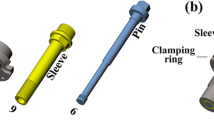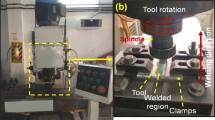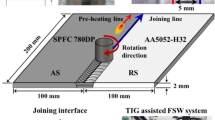Abstract
In this study, the joining of 6061-T6 aluminum alloy and DP590 steel using a M42 steel rivet via friction riveting technique is investigated. The surface morphology and microstructure characterization reveal the formation of an anchor zone that imparts mechanical interlock as well as the formation of metallurgical bonds at the interface of aluminum and steel. A combination of interlocking and bonding results in the achievement of a high load-carrying capacity of 5.7 kN during lap shear testing at room temperature. A finite element-based computational model was developed which accurately predicted the lap shear response of the joint. The model revealed that the metallurgical bond formed during fric-riveting adds 39% peak load strength to the joint. An extensive microstructural investigation, post-lap-shear fractography, and the modeling results, together provided insights on the joint failure mechanism. This study highlights that friction riveting is a promising method for aluminum-to-steel dissimilar joining, which is important for lighweighing automotive vehicles for energy efficiency.










Similar content being viewed by others
Change history
26 August 2023
A Correction to this paper has been published: https://doi.org/10.1007/s00170-023-12219-x
References
J.C. Benedyk (2010) Aluminum alloys for lightweight automotive structures, in: P.K. Mallick (Ed.) Materials, Design and Manufacturing for Lightweight Vehicles, Woodhead Publishing 79–113 https://doi.org/10.1533/9781845697822.1.79
Cole GS, Sherman AM (1995) Light weight materials for automotive applications. Mater Charact 35:3–9. https://doi.org/10.1016/1044-5803(95)00063-1
Basak S, Das H, Pal TK, Shome M (2016) Characterization of intermetallics in aluminum to zinc coated interstitial free steel joining by pulsed MIG brazing for automotive application. Mater Charact 112:229–237. https://doi.org/10.1016/j.matchar.2015.12.030
Gould J (2012) Joining aluminum sheet in the automotive industry—A 30 year history. Weld J 91:23–34
T. Sakiyama, G. Murayama, Y. Naito, K. Saita, Y. Miyazaki, H. Oikawa, T. Nose, Dissimilar Metal Joining Technologies for Steel Sheet and Aluminum Alloy Sheet in Auto Body, Tokyo, Japan, 2013, pp. 91–98. https://www.nipponsteel.com/en/tech/report/nsc/pdf/103-14.pdf.
Haghshenas M, Gerlich AP (2018) Joining of automotive sheet materials by friction-based welding methods: A review. Eng Sci Technol (JESTECH) 21:130–148. https://doi.org/10.1016/j.jestch.2018.02.008
Zhang HT, Feng JC, He P, Hackl H (2007) Interfacial microstructure and mechanical properties of aluminium–zinc-coated steel joints made by a modified metal inert gas welding–brazing process. Mater Charact 58:588–592. https://doi.org/10.1016/j.matchar.2006.07.008
X. Sun, E.V. Stephens, M.A. Khaleel, H. Shao, M. Kimchi, Resistance spot welding of aluminum alloy to steel with transition material-from process to performance-part I: experimental study, Weld. J., 83 (2004) 188-S. http://img2.aws.org/wj/supplement/06-2004-SUN-s.pdf.
Das H, Ghosh RN, Pal TK (2014) Study on the Formation and Characterization of the Intermetallics in Friction Stir Welding of Aluminum Alloy to Coated Steel Sheet Lap Joint. Metall Mater Trans A 45:5098–5106. https://doi.org/10.1007/s11661-014-2424-9
Lou M, Li Y, Wang Y, Wang B, Lai X (2014) Influence of resistance heating on self-piercing riveted dissimilar joints of AA6061-T6 and galvanized DP590. J Mater Process Technol 214:2119–2126. https://doi.org/10.1016/j.jmatprotec.2014.03.006
Anaman SY, Cho H-H, Das H, Lee J-S, Hong S-T (2019) Microstructure and mechanical/electrochemical properties of friction stir butt welded joint of dissimilar aluminum and steel alloys. Mater Charact 154:67–79. https://doi.org/10.1016/j.matchar.2019.05.041
Mahto RP, Anishetty S, Sarkar A, Mypati O, Pal SK, Majumdar JD (2019) Interfacial Microstructural and Corrosion Characterizations of Friction Stir Welded AA6061-T6 and AISI304 Materials. Met Mater Int 25:752–767. https://doi.org/10.1007/s12540-018-00222-x
D. Duthinh (2000) Connections of fiber-reinforced polymer (FRP) structural members: a review of the state of the art
Amancio Filho SDT, Beyer M, Dos Santos JF (20019) Method of connecting a metallic bolt to a plastic workpiece, in, GKSS Forshungszentrum Geesthacht GmbH, US, pp. 12. https://patentimages.storage.googleapis.com/a8/75/db/95e6ac481fded6/US7575149.pdf.
Blaga L, dos Santos JF, Bancila R, Amancio-Filho ST (2015) Friction Riveting (FricRiveting) as a new joining technique in GFRP lightweight bridge construction. Constr Build Mater 80:167–179. https://doi.org/10.1016/j.conbuildmat.2015.01.001
Borba NZ, Blaga L, dos Santos JF, Amancio-Filho ST (2018) Direct-Friction Riveting of polymer composite laminates for aircraft applications. Mater Lett 215:31–34. https://doi.org/10.1016/j.matlet.2017.12.033
Borba NZ, Kötter B, Fiedler B, dos Santos JF, Amancio-Filho ST (2020) 2020 Mechanical integrity of friction-riveted joints for aircraft applications. Compos Struct 232:111542. https://doi.org/10.1016/j.compstruct.2019.111542
Wang B, Xu L, Guo B, Zhang H (2021) Process and performance characteristics of an improved friction-stir riveting process. J Manuf Process 62:234–246. https://doi.org/10.1016/j.jmapro.2020.12.047
Abaqus 6.11, Dassault Systemes Simulia Corporation, Providence, RI, USA, 2011. https://www.3ds.com/.
A. Rohatgi, WebPlotDigitizer user manual version 3.4, 2014, 1–18. http://arohatgi.info/WebPlotDigitizer/app.
K Vedantam, D Bajaj, NS Brar, S Hill in 14th APS Topical Conference on Shock Compression of Condensed Matter - 2005,. (eds M.D. Furnish, M. Elert, T.P. Russell, C.T. White) 775–778 (American Institute of Physics). https://doi.org/10.1063/1.2263437
Akram S, Jaffery SHI, Khan M, Fahad M, Mubashar A, Ali L (2018) Numerical and experimental investigation of Johnson-Cook material models for aluminum (Al 6061–T6) alloy using orthogonal machining approach. Adv Mech Eng 10:1687814018797794
G.R. Johnson. in Proceedings: Seventh International Symposium on Ballistics. 541–547 (American Defense Preparedness Association). https://www.scienceopen.com/document?vid=3e0958f1-d0dd-4475-a068-5dc192c6056f.
Hassannejadasl A, Green DE, Golovashchenko SF, Samei J, Maris C (2014) Numerical modelling of electrohydraulic free-forming and die-forming of DP590 steel. J Manuf Process 16:391–404. https://doi.org/10.1016/j.jmapro.2014.04.004
Johnson GR, Cook WH (1985) Fracture characteristics of three metals subjected to various strains, strain rates, temperatures and pressures. Eng Fract Mech 21:31–48. https://doi.org/10.1016/0013-7944(85)90052-9
Pina Cipriano G, Ahiya A, dos Santos JF, Vilaça P, Amancio-Filho ST (2019) Single-phase friction riveting: metallic rivet deformation, temperature evolution, and joint mechanical performance. Weld World 64(2019):47–58. https://doi.org/10.1007/s40194-019-00803-3
Liedl U, Traint S, Werner EA (2002) An unexpected feature of the stress–strain diagram of dual-phase steel. Comput Mater Sci 25:122–128. https://doi.org/10.1016/S0927-0256(02)00256-2
Paul SK (2013) Effect of material inhomogeneity on the cyclic plastic deformation behavior at the microstructural level: micromechanics-based modeling of dual-phase steel. Modell Simul Mater Sci Eng 21:055001
Huang C, Kou S (2002) Liquation mechanisms in multicomponent aluminum alloys during welding. Weld J 81:211–222
Wang X, Ma P-K, Zhang S-Y, Liu X, Wang C, Wang D-W, Wang H-Y (2022) High-ductility AA6061 alloys produced by combination of sub-rapid solidification and Cr-alloying. J Market Res 18:1566–1577. https://doi.org/10.1016/j.jmrt.2022.03.034
Ambat R, Davenport AJ, Scamans GM, Afseth A (2006) Effect of iron-containing intermetallic particles on the corrosion behaviour of aluminium. Corros Sci 48:3455–3471
Luo Y-W, Guo H-J, Sun X-L, Guo J, Wang F (2018) Influence of Tempering Time on the Microstructure and Mechanical Properties of AISI M42 High-Speed Steel. Metall Mater Trans A 49:5976–5986. https://doi.org/10.1007/s11661-018-4924-5
Kim J, Lee H, Choi H, Lee B, Kim D (2020) Prediction of load–displacement curves of flow drill screw and RIVTAC joints between dissimilar materials using artificial neural networks. J Manuf Process 57:400–408. https://doi.org/10.1016/j.jmapro.2020.06.039
Zhang G, Zhao H, Xu X, Qiu G, Li Y, Lin Z (2019) Metallic bump assisted resistance spot welding (MBaRSW) of AA6061-T6 and Bare DP590: Part II-joining mechanism and joint property. J Manuf Process 44:19–27. https://doi.org/10.1016/j.jmapro.2019.05.041
Huang Y, Huang T, Wan L, Meng X, Zhou L (2019) Material flow and mechanical properties of aluminum-to-steel self-riveting friction stir lap joints. J Mater Process Technol 263:129–137. https://doi.org/10.1016/j.jmatprotec.2018.08.011
Shan H, Ma Y, Niu S, Yang B, Lou M, Li Y, Lin Z (2021) Friction stir riveting (FSR) of AA6061-T6 aluminum alloy and DP600 steel. J Mater Process Technol 295(2021):117156. https://doi.org/10.1016/j.jmatprotec.2021.117156
Oliveira JP, Ponder K, Brizes E, Abke T, Edwards P, Ramirez AJ (2019) Combining resistance spot welding and friction element welding for dissimilar joining of aluminum to high strength steels. J Mater Process Technol 273(2019):116192. https://doi.org/10.1016/j.jmatprotec.2019.04.018
Li L, Reza-E-Rabby Md, Overman N, Wang T, Whalen S, Grant G, Mathaudhu S, Soulami A (2022) Analysis of contact conditions and microstructure evolution in shear assisted processing and extrusion using smoothed particle hydrodynamics method. Mater Des 221:111010
Li, Lei, Varun Gupta, Xiao Li, Anthony P. Reynolds, Glenn Grant, Ayoub Soulami (2021) "Meshfree simulation and experimental validation of extreme thermomechanical conditions in friction stir extrusion." Comput Part Mech (2021): 1–21
Funding
This work was supported by the U.S. Department of Energy’s Vehicle Technology Office (DOE/VTO). Pacific Northwest National Laboratory is operated by Battelle Memorial Institute for the DOE under contract DE-AC05-76RL01830. The authors would like to thank Nathan Canfield, Anthony Guzman, Angel Ortiz, Ethan Nickerson, and Robert Seffens for their technical assistance.
Author information
Authors and Affiliations
Contributions
All authors contributed to different phase of this study. Abhinav Srivastava: Investigation, Writing—original draft, Hrishikesh Das: Investigation, Writing—review & editing, Daniel Ramirez Tamayo: Formal analysis, Writing—review & editing. Lei Li: Formal analysis, Writing—review & editing. Mayur Pole: Investigation, Writing—review & editing. Bharat Gwalani: Investigation, Writing—review & editing. Ayoub Soulami: Supervision, Formal analysis. Jorge F. dos Santos: Conceptualization, Supervision, Writing—review & editing. Keerti S. Kappagantula: Funding acquisition, Conceptualization Writing—review & editing. *Md. Reza-E-Rabby: Supervision, Conceptualization, Investigation, Methodology, Writing—review & editing.
Corresponding author
Ethics declarations
Competing interest
The authors declare no conflict of interest. The authors have no relevant financial or non-financial interests to disclose. The views and opinions of the authors expressed herein do not necessarily state or reflect those of the United States Government or any agency thereof. Neither the United States Government nor any agency thereof, nor any of their employees, makes any warranty, expressed or implied, or assumes any legal liability or responsibility for the accuracy, completeness, or usefulness of any information, apparatus, product, or process disclosed, or represents that its use would not infringe privately owned rights.
Additional information
Publisher's note
Springer Nature remains neutral with regard to jurisdictional claims in published maps and institutional affiliations.
The original online version of this article was revised: The copyright holder name of this paper should be: © Battelle Memorial Institute 2023.
Supplementary Information
Below is the link to the electronic supplementary material.
Rights and permissions
About this article
Cite this article
Srivastava, A., Das, H., Tamayo, D.R. et al. Extent of interlocking and metallurgical bonding in friction riveting of aluminum alloy to steel. Int J Adv Manuf Technol 128, 2899–2911 (2023). https://doi.org/10.1007/s00170-023-12111-8
Received:
Accepted:
Published:
Issue Date:
DOI: https://doi.org/10.1007/s00170-023-12111-8




